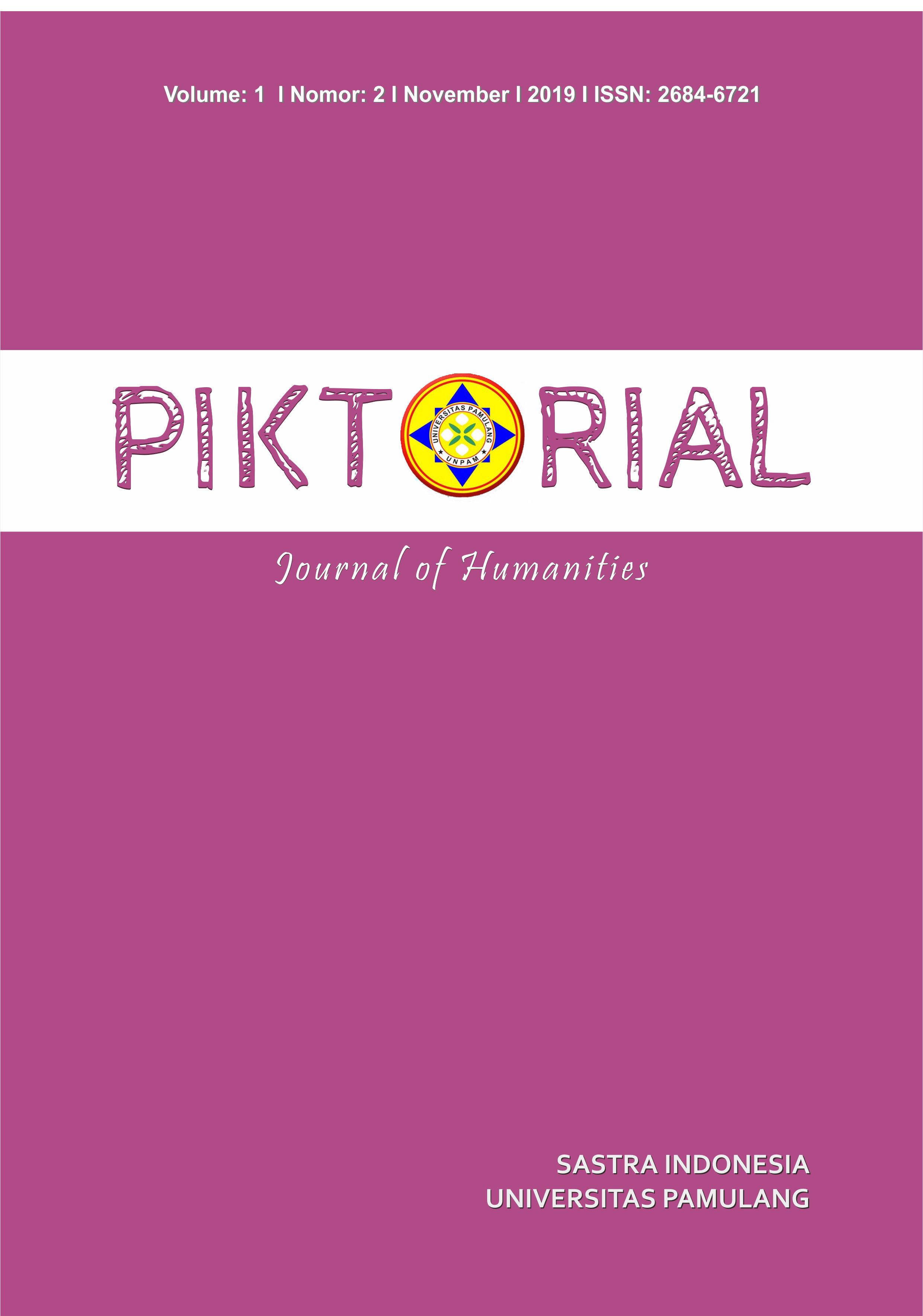THE EFFECT OF VIDEO ON READING COMPREHENSION AND READING INTEREST
DOI:
https://doi.org/10.32493/piktorial.v1i2.3775Abstract
The Objectives of this study were to get empirical evidence about the difference in reading achievement between students who were taught English by using Video and those who were not. The design of the study was a factorial design of 2 X 2. The samples of the study were taken from the eighth-grade students of SMPN 11 Kota Tangerang Selatan. The design used to take the samples of the study was Nonequivalent control group design. There were two classes that became sample classes, they were 8.1 class and 8.2 class, each class has forty-one students so there were eighty-two students as a sample, 8.1 class was as a controlled class while 8.2 class was as an experimental class. The experimental class was given a video while the controlled class was not. There were two kinds of instruments used for the research. The first instrument was a test and the second one was a questionnaire. The test was aimed at measuring students’ reading comprehension while the questionnaire was aimed at measuring students’ reading interest. The results of the test were in the form of a gained score which was analyzed by using Anova with the significance level is 5%. It was found that the mean score for experimental class was 23 and for controlled class was 22, meanwhile, the modus score of the experimental class was 22 and for control, class was 20 and then the statistical computation on the gained score revealed that the significance value of Video, Reading Interest and both interactions toward reading comprehension had significance value lower than 0.05 (>0.05) while the t-table value 5%.
Keywords: Video, Reading Comprehension, Reading Interest
References
Anderson Kenneth ., Maclean Joan., & Lynch Tony. (2004). Study Speaking a Course in Spoken a Course in Spoken English for Academic Purposes (Second edition). Cambridge University Press.
Anglista di Collana. (2010). English But Not Quite Locating Linguistic Diversity.Italy: Tangram Scientitiche Trente.
Bishop, A., & Bishop, S. (2010). Teaching Word Analysis.USA: Shell Education.
Bneuman, S., & Dikinson, D. K. (2011).Handbook of Early Literacy Research Volume 3.New York: The Guilford Press.
Depdiknas, PeraturanMenteriPendidikanNasional, No 22 Th. 2006 Tentang standarisi Matapelajaran Bahasa Inggris untuk sekolah menengah pertama / Madrasahah Tsanawiyah ,Jakarta.
Goodwyn Andrew & Branson Jano. (2005). Teaching English, USA: Routhledge Falmer.
Goudiss Charles. (2014). Questions to Know by Test Day Act English and Reading. McGraw Hill Education for Colledge and Career Success: McGraw Hill’s 500.
Hiebert, E. H. (2008), Reading more, Reading better.New York: The Guilford Press.
International Journal of Education and Development using information and communication technology. (2007). Effectiveness of Video as an Instructional Medium in teaching rural children agricultural and environmental sciences, Babalola, Isiaka, Lagos State University, Nigeria.IJEDICT.
International Conference in Frontiers of Energy, Environmental Materials and Engineering. (2013). Shanghai, China: Destech Publications, Inc. USA.p. 412)
Dennis, M. Mc Inerney., & Etten, S. V. (2005). Focus on Curriculum.Information Age Publishing, Inc.
Jenkins Jennifer. (2003). Word Englishes, A Reource Book for Students. New York: Routhledge Taylor & Francis Group.
Johnson, R.B., & Christensen, L. (2014).Educational Research.USA: Sage Publications Inc.
Kristen Lems, et. Al. (2010). Teaching Reading to English Langusge learners: Insight from Linguistics. New York: The Guilford Press.
McNamara S Danielle. (2007). Reading Comprehension Strategies. USA: Lawrence Erlbaum Associates
Mazrul M Alamin. (2004). English In Africa after the Cold War. The Cromwel Press Limited.
Meltzer, L. (2007). Executive Function in Education.New York: Guilford Press.
Meyer F Charles. (2009). Introducing English Linguistics.Singapore: Cambridge University Press.
Mitchell, N., & Pearson, J. (2012). Inquring In the Classroom.London: Continuum International Publishing Group.
Mukalel, J. C. (2007). Creative Approaches to Classroom Teaching.New Delhi: Discovery Publishing House.
Mark Shiu-Kee Shum De Lu Zhang. (2005). Teaching Writing in Chinese Speaking Areas. USA: Springer.
Medina Conni. (2008). Succesful Strategies for Reading in the Content Areas. Shell Educational Publishing, Inc.
Naomi Flynn and Rhona Stainthorp. (2006). The Learning and Teaching of Reading and Writing.Chichester: John Wiley & Sons Ltd.
Namara, D. S. Mc.(2007). Reading Comprehension Strategies. New jersey: Lawrence Erlbaum Associates, Inc.
Oakhill, J., Cain, K., & Elbro C. (2015). Understanding and Teaching Reading Comprehension, New York: Routhledge.
Prior, J., & Gerard, M. R. (2004).Environmental Print for Early Childhood Literacy Skills, USA: Shell Education.
Paul Eggen & Don Kauchak, Educational Psychology. (2010). Windows on classrooms, New Jersey, Pearson Education, Inc.
Raymond Philippot and Michael F. Graves. (2009). Fostering Comprehension in English Classes, New York: A Division of Guilgford Publications, Inc, p. 107.
Ritchie, C. & Thomas, P. (2012). Successful Study Skills for Teaching Assistants, New York:Routhledge.
Standar Kompetensi Mata pelajaran BahasaInggris SMP dan MTS. (2003). Jakarta: DepartemenPendidikan Nasional.
Taylor Seargeant Philip. (2012).Language in a Global Context. New York: Francis Group London
Turow Joseph & Kavaraugh L Andrea. (2003). The Wired Homestead. Cambridge, Massachussets, London, England: The Mit Press.
Westwood, P. (2008). What Teachers Need to Know about Reading and Writing difficulties. Australia: Acer Press.
William, G. (2009). Reading in a Second Language: Moving from Theory to Practice.New York: Cambridge University Press.
Woolfolk, A. (2004). Educational Psychology.New York: Pearson Education Inc.
WWW.Slidesshare.net/Pedrol Martinez/Advantages of Video Based Instruction
Yan Zhihong. (2000), Learning World. English Teaching Forum, Vol. 38, No.3.

